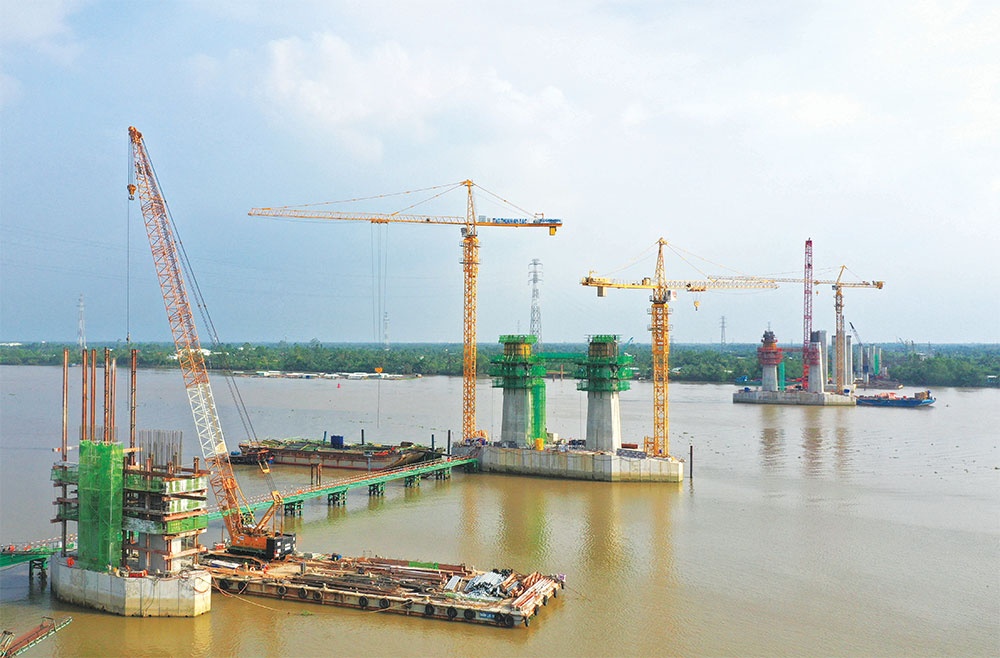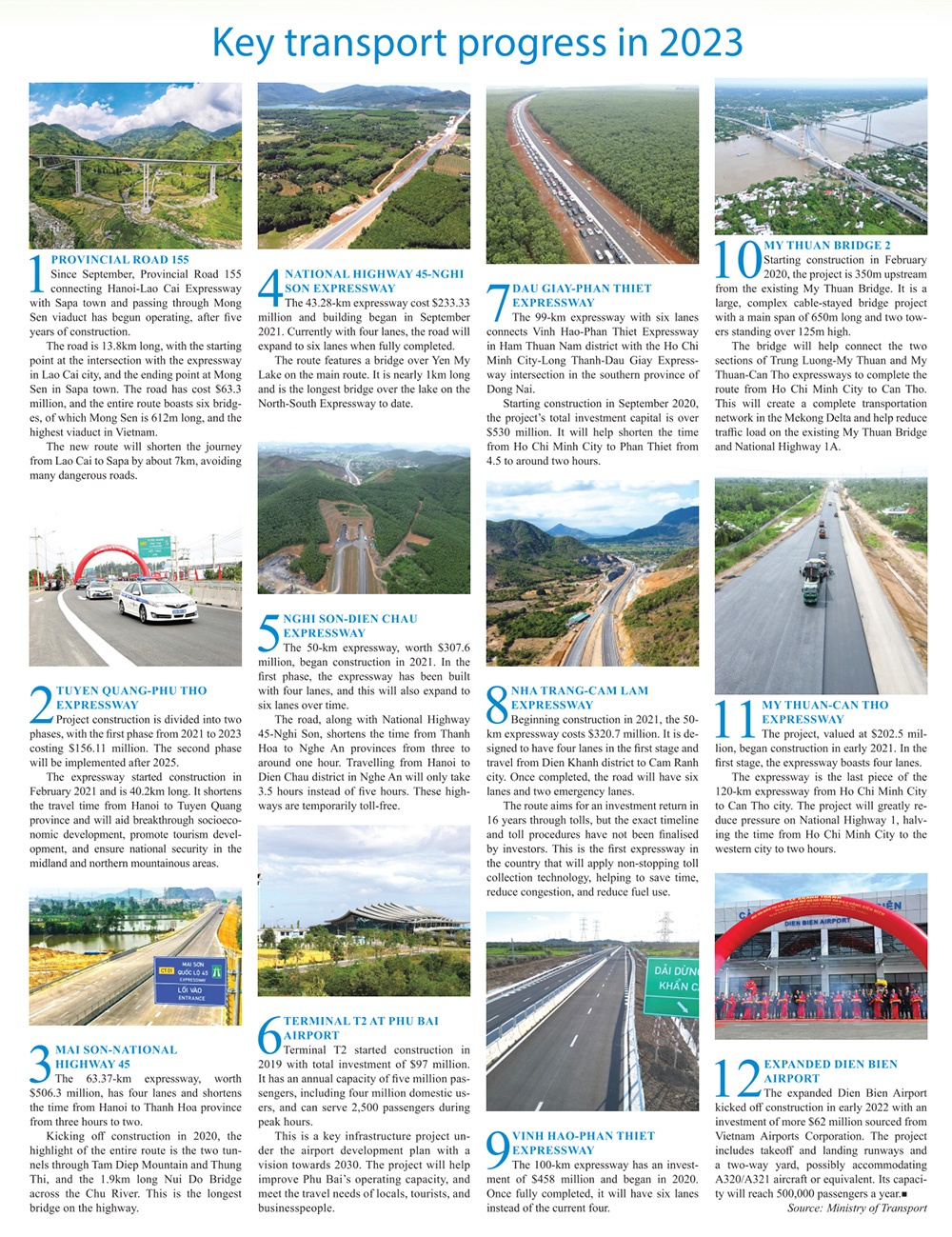Infrastructure impetus lights way for transport
| Nguyen Van Thang, Minister of Transport
In 2023, the transport sector made some important results, contributing to the country’s overall achievements. The first was institutional breakthroughs. The Ministry of Transport (MoT) focused on reviewing and improving the quality of institutions and policy mechanisms, significantly removing complexities facing individuals, businesses, and localities. This helped to unlock, mobilise, and effectively use all resources, making an important contribution to sustainable socioeconomic development. Last year, the ministry issued 40 circulars, submitted 13 decrees to the government, coordinated with the Ministry of Planning and Investment on road project investment policies, completed the draft Road Law, and completed a dossier to request development of the Railway Law and Vietnam Civil Aviation Law. The MoT also completed all targets and tasks assigned by the government on building e-government and digital transformation. Secondly, 2023 was truly a year of many breakthroughs in investment in transport infrastructure, with the commencement of 26 projects. Construction started on 12 components of the eastern cluster of the North-South Expressway’s phase 2; East-West Expressway ventures; urban belt routes in Hanoi and Ho Chi Minh City; Long Thanh airport terminal; Terminal 3 for Tan Son Nhat International Airport, and others. The ministry has taken a number of drastic solutions and measures to fulfill the public investment disbursement target. Transport activities continue to maintain a stable growth momentum associated with strong reductions in administrative procedures, fees, and promotion of IT applications. By the end of November, cargo output increased by 12.9 per cent and passenger output increased by 11.5 per cent, compared to the same period last year. Meanwhile, international cooperation has been promoted and achieved results, deepening relations with neighbouring countries and important partners in the transportation sector. About 10 international treaties and three international agreements on transportation were signed. Last year, the MoT also drastically implemented many synchronous solutions to handle shortcomings in registry activities. By June 2023, congestion at registry centres had been resolved. Currently, we are focusing on implementing solutions to comprehensively innovate registration activities to create open, transparent, and modern registration, thus improving service quality and creating convenience for individuals and businesses. While making these achievements, there are still a number of limitations that need to be considered and resolved to achieve more substantial changes. They include problems in the management of transportation activities and traffic accidents. Although many expressway projects have been put into operation in Vietnam, rest stops have not been invested in synchronously. Moreover, attracting social investment in developing transport infrastructure is still limited and has not yet met expectations. |
 |
| Upgrades over road, air, and sea are helping to open up Vietnam for more trade and investment, photo Le Toan |
Leading up to the end of 2023, key figures at the Ministry of Transport (MoT) continued to work with units on a list of new projects for this year to strengthen regional links for national socioeconomic development.
The MoT is preparing to kick off at least 19 transport projects in 2024 to continue its efforts to develop transport infrastructure.
Among the new ventures, over a dozen are in the road segment, including Dau Giay-Tan Phu Expressway, Lo Te-Rach Soi Expressway, and Cho Moi-Bac Kan Expressway. Other initiatives include a railway project to upgrade the Khe Net pass railway route of the Hanoi-Ho Chi Minh City railway line; a maritime project to upgrade Quy Nhon channel for 50,000DWT ships; and an aviation scheme to build an information system for managing vehicles and air traffic infrastructure.
Along with the MoT, cities and provinces are also making preparations for their new transport infrastructure ventures. Specifically, the Ho Chi Minh City Department of Transport in late 2023 proposed to the municipal People’s Committee a list of almost 60 transport projects prioritised for investment for the rest of this decade, at a cost of $9.74 billion.
Of the sum, state funding makes up 67.8 per cent, while the rest will be mobilised under the public-private partnership for 21 projects. According to the city, in 2026-2030, it will apply specific policies to call for private investment, speed up implementation progress, and promote effectiveness.
The plans are expected to open opportunities for the private sector to join. Transport is one of the sectors that already engages strong interest among domestic private businesses and international groups such as Indian conglomerate Adani Group and International Holdings Company from the UAE, as well as those from Japan and China.
Big steps of 2023
Transport continues to boast major national projects that have been underway for several years now, playing a vital role in socioeconomic development (see Page 9), and some phases of such projects are now complete. On December 24, Prime Minister Pham Minh Chinh attended the inauguration ceremony of four projects: Dien Bien Airport expansion; Tuyen Quang-Phu Expressway; My Thuan-Can Tho Expressway, and My Thuan 2 Bridge.
Meanwhile, in 2023, disbursement of public investment was also a spotlight in the sector’s performance. The MoT was allocated the biggest-ever amount of public investment of about $4 billion last year.
Of the sum, $1.9 billion was invested in the North-South Expressway’s second phase for 2021-2025. The MoT has disbursed over 95 per cent, making it one of the ministries with the highest public investment disbursement rate.
Such strong performance in public investment disbursement has resulted in successful completion of many key transport projects. Deputy Minister Tho noted, “In 2023, 475km of expressways have been put into use, increasing the total figure in the country to almost 1,900km, meaning we are on the right track to achieve the target of developing 3,000 km of expressway by 2025.”
In 2024, the transport sector aims to continue focus on completing institutions, and increase transport output by about 7 per cent, the number of passengers by 8 per cent, and the volume of goods through Vietnam’s seaports by 4 per cent on-year. It also aims to reach a 95 per cent public investment disbursement rate yet again.
Private investment yet to shine
According to Assoc. Prof. Dr. Tran Chung, chairman of the Vietnam Association of Road Traffic Investors, member companies eye opportunities to join transport ventures. However, the country needs to make further enhancements in the legal framework for transport projects to facilitate private investment.
“More advantages, including a clear risk-sharing mechanism, will encourage new players to join. Vietnam’s transport infrastructure has not attracted many private investors mainly because of legal problems,” he said.
According to the Vietnam Expressway Authority, for projects invested under the forms of the public-private partnership (PPP) or private investment engagement last year, it has advised on contract management of the eastern North-South Expressway component projects for some components. To date, the Nha Trang-Cam Lam has been put into operation, while the remaining projects hope for completion in 2024.
Problems in attracting PPP transport projects have been a concern for years. At the sixth session of the 15th National Assembly (NA) in November, they were once again raised. NA deputies agreed that problems related to risk sharing, while government guarantees have not been fully resolved as expected.
Moreover, it is still difficult for businesses to access loans from credit institutions to invest in transport infrastructure projects.
NA delegate Vu Tien Loc representing Hanoi said, “Accessing bank credit for PPP transport projects is very difficult. If it is possible to increase state capital contribution even to 85-90 per cent, then only 10-15 per cent comes from private investment, and it is possible to complete projects in the best way. If so, it is not necessary to get bank credit.”
NA deputies also asked for the NA to amend the law on PPP investment to more accurately meet current and future needs.
 |
What the stars mean:
★ Poor ★ ★ Promising ★★★ Good ★★★★ Very good ★★★★★ Exceptional
Related Contents
Latest News
More News
- Global partnerships key to Vietnam’s IFC development (December 26, 2025 | 16:18)
- Vingroup pulls out of bid to invest in North-South high-speed railway (December 26, 2025 | 11:42)
- Strengthening supply chains through trade promotions and customs reform (December 24, 2025 | 14:00)
- PM orders investment model for North–South high-speed rail (December 22, 2025 | 17:43)
- LS Eco Energy to invest in Vietnam rare earth sector (December 22, 2025 | 17:31)
- Government moves to establish International Financial Centre (December 21, 2025 | 21:00)
- Vietnam's IFC to target global investment flows (December 21, 2025 | 18:00)
- Two national hospitals expand capacity with new facilities (December 20, 2025 | 09:00)
- Ha Tinh breaks ground on major Vingroup industrial and energy projects (December 19, 2025 | 18:24)
- EVN launches major power infrastructure projects nationwide (December 19, 2025 | 18:17)


 Tag:
Tag:





















 Mobile Version
Mobile Version